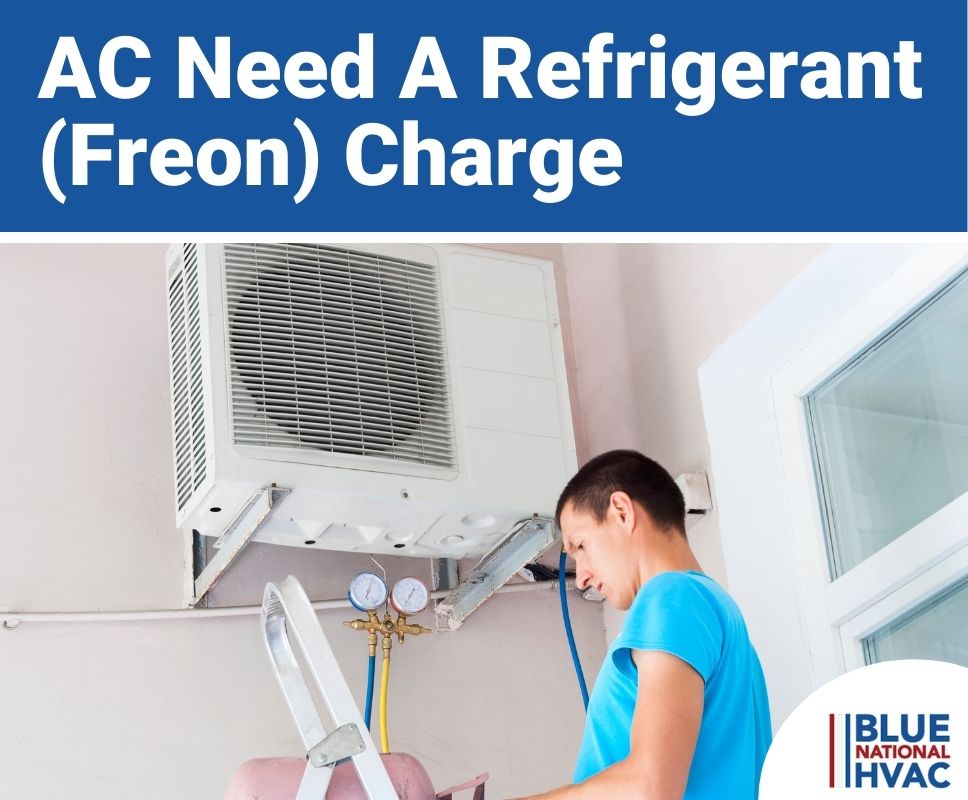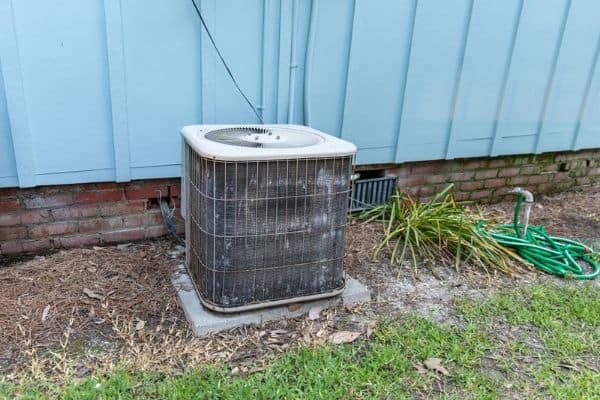And much more!
So, if you’re looking for tips on fixing a central air conditioner that’s not cooling, keep reading our detailed guide below to get answers to all of your questions!
How Do You Troubleshoot and Fix An Air Conditioner That’s Not Cooling?
It’s the dead of summer, your home is hot, and your AC unit is not cooling your home down to comfortable temperatures. What gives? Is your air conditioning unit broken?
This section covers what you, as a homeowner, can do to troubleshoot your air conditioner and determine why it is not cooling your home. However, the bottom line is that for most things, you should have an HVAC technician inspect and fix the cooling problems to ensure it’s done properly.
Check Your Thermostat
If you’re feeling hot inside your home and you know the air conditioning system is on, check your thermostat. Make sure it is in cooling mode and that the fan setting is on “auto.” Is the setpoint lower than the temperature in your home?
If so, then the air conditioner should be running. If it isn’t running, then you might have equipment failure or a tripped breaker. On the other hand, if the AC unit is running, move on to checking the ductwork.
Inspect Your Ductwork
Visit each room in your home and ensure that all return and supply vents are fully open. Also, while the air conditioner is running, place your hand in front of the supply vents and verify that cold air is blowing. If warm air is coming through, then there’s an issue with the evaporator, compressor, or there might be a refrigerant leak, among other possibilities.
Additionally, inspect the visible ductwork in your basement or attic. If there are any loose or open junctions, those will need to be addressed and fixed by an HVAC professional.
Check the Circuit Breaker
Before calling our HVAC technicians for help, check the circuit breaker. If the circuit breaker has tripped, go to your electrical panel and flip it back into the “auto” position. If the air conditioner immediately trips the breaker again, leave the breaker in the off position.
Suppose your AC unit is repeatedly tripping the breaker. In that case, it could be a sign of a more extensive electrical issue like a failed capacitor, relay, or contactor, or worse – a failed compressor. These equipment failures require AC repair from an HVAC technician.
Inspect Your Air Filter
A common culprit of air conditioning systems not cooling is dirty and blocked air filters. Clogged AC filters prevent proper airflow, and without enough cool airflow into your home, the AC unit will struggle to cool. Make sure you turn off your air conditioner before you pull out the filter.
Check the filter on your indoor unit – if it is covered in dust or pet hair, it’s time to clean it or replace it.
After replacing or cleaning the filter, turn on your system, give your air conditioner a few hours, and see if your home gets cooler. If not, you might have a different issue entirely.
Check the Evaporator Coils
Another reason your air conditioning system could not be cooling your home could be from the evaporator coils being clogged with dust and dirt. If your filter goes unchecked and uncleaned for too long, the dust and dirt can overflow onto your evaporator coils.
To view your evaporator coils, remove the cover of the indoor unit. If the evaporator coils look visibility dirty, they will need to be cleaned. Use a shop vacuum and coil cleaner foam to get the evaporator clear and your airflow restored. Review our coil cleaning guide for full details on how to fix this cooling-related issue!
Clear The Condenser Unit
If your air conditioning unit is not cooling, another area you can check is your condenser unit. The condenser unit, also known as the outdoor unit, sits outside your house and contains the condenser coils, compressor, and a fan on the top. If the condensing coils are clogged, or the fan is blocked from spinning by debris, such as a branch, it could prevent your AC system from cooling properly.
The condenser coils eject excess heat from the refrigerant in your air conditioning system. If it can’t perform its function of removing heat from the home, then the AC unit will poorly cool your home.
The condenser unit can be DIY cleaned by homeowners or by our HVAC experts (check out our guide here). Call us today if you need assistance!
Common AC Problems That Prevent Your Conditioner From Cooling Your Home
There are many reasons your air conditioner may not be cooling your home. Including what we suggested to check in the troubleshooting section, your AC unit can have cooling issues from the following common causes.
Clogged, Dirty Filter
Dirty air filters clogged with dirt, dust, pet hair, or a combination of these particulates block airflow and prevent proper cooling. Cleaning or replacing your air filter will improve airflow, cooling, and indoor air quality.
Refrigerant Leaks
If your AC unit has a refrigerant leak, then its cooling capacity is compromised. The refrigerant within your air conditioning coils cools the air in your home by removing heat and transferring the heat to the outdoors via the condenser.
If there are low refrigerant levels in your coils, this cooling process cannot take place. Therefore, your air conditioning system will not be able to cool your home. Refrigerant leaks can only be serviced by licensed HVAC technicians that carry an EPA certification.
Frozen Coils
If your evaporator coils have a refrigerant leak, it could cause a build-up of ice on your coils. To remove humidity, moisture from the air condenses onto the evaporator coils before dripping into the condensate pan.
When there’s a pinhole refrigerant leak on the coil, refrigerant escapes the higher pressure coil into the lower pressure exterior undergoing a rapid pressure reduction. When a gas rapidly loses pressure, it cools. This cooling effect will freeze the condensed water, and over time, it could build up covering of ice on your evaporator coils.
An iced-over evaporator coil does not let any air pass through, meaning your AC won’t be able to provide cool air into your home.
Wrong Thermostat Setting
An incorrect thermostat setting could be an easily overlooked reason your central AC unit is not cooling. Double-check the thermostat to make sure it’s set to cooling mode, the correct setpoint, and the fan is set to “auto.”
Condenser Problems
A neglected condenser could be the reason for an AC not cooling. The condenser, or outdoor unit, ejects hot air from the air conditioning system and is an integral part of the vapor-compression refrigeration cycle. The four walls of the condensing unit are made up of coils and fins which airflow can pass through.
The fan at the top of the condenser pulls outside air through the fins and coils and ejects it upward. The airflow over the condensing coils captures and removes heat in the coils, cooling them. When the condenser coils are clogged with dirt, it will have trouble exchanging its heat with the outdoor because of the restriction in airflow.
On the other hand, if the fan motor on the condenser is blocked in some fashion, such as by a fallen branch, it will not provide sufficient cooling to the coils.
Broken Electrical Components
Failed electrical components within the condenser unit and air handler unit can prevent your air conditioning unit from cooling. Examples of faulty electrical components include:
- Fan – The fan motors that control your indoor and outdoor fans are subject to failure and could be reasons your AC system isn’t cooling
- Relay – A bad compressor relay will prevent your compressor from kicking on, bringing the cooling process to a halt
- Capacitor – A failed capacitor, which energizes the compressor during startup, will prevent it from running
- Fuse – A blown fuse on your condenser unit will prevent power from getting to it
- Circuit breaker – If the circuit breaker that power your AC unit fails, this will not only cut power to your indoor and outdoor units but your thermostat too
Why Is Your AC Running But Not Cooling?
In many cases, air conditioners continue to run while not providing cooling to the home. For most of the common reasons listed above, the air conditioner will still run in some capacity.
For example, if you have a refrigerant leak, block condenser, clogged filter, bad blower motor, and other condenser/compressor issues, your thermostat and indoor fan could still run. However, the home will not be cooled as long as these issues are still present.
When Should You Call An HVAC Specialist?
If your air conditioner is not cooling, you need to call a certified professional for repair. As a homeowner, you can DIY troubleshoot to determine the issue and even fix some yourself (like a dirty filter).
However, more extensive and involved repairs, such as a failed capacitor, are best left for an HVAC technician to repair. Give our licensed HVAC technicians a call today if you’re having cooling problems!
What Will An HVAC Specialist Check?
When our HVAC technician arrives on their service call to inspect your HVAC system that is not cooling, they will check and troubleshoot the following equipment and components:
- Outside unit and condenser coils
- Refrigerant lines
- Compressor
- Capacitor, relay, and contactor
- Fuse and circuit breaker
- Air filter
- Both fans and blower motors
- Evaporator coils
- Refrigerant levels
Once they’ve identified the issue, they’ll help you choose the best course of action for your unique situation so your home can still be cool and comfortable during those hot days of summer!









